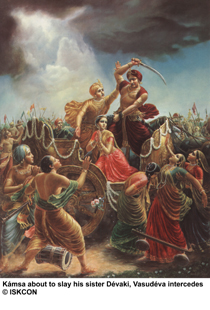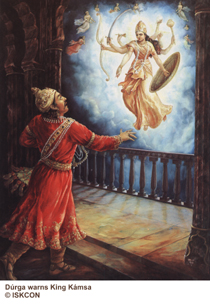Ashutosh Vardhana:
The birth of Lord Kríshna
(Version 1)
Ashutosh Vardhana:
The birth of Lord Kríshna (Version 1) |
Note for Editors:
There are three versions of this article:
- Version 1, length 400 words, which explains the story underlying this festival and its theology (divine incarnations).
- Version 2, length 1330 words, which consists of version 1 plus information of festival customs at home and in temples, the significance of Lord Kríshna for Hindus, and comparisons with Christian beliefs (childhood of Jesus). Additional illustrations can be found in Version 2.
- Version 3, length 890 words, same as version 1, plus information on customs and rituals, but omitting similarities between Kríshna and young Jesus. For greater choice of illustrations see Version 2.
Editorial introduction:
![]() On
31 August this year (2002), Hindus celebrate the festival of Kríshna Janmáshtami,
the birth of Lord Kríshna. Ashutosh Vardhana explains the significance
of this festival.
On
31 August this year (2002), Hindus celebrate the festival of Kríshna Janmáshtami,
the birth of Lord Kríshna. Ashutosh Vardhana explains the significance
of this festival.
Version 1
Ashutosh Vardhana:
The birth of Lord Kríshna
![]() Hindus believe that the one invisible GOD THE ABSOLUTE, manifests in the
shape of many personal gods and appears in material form from time to
time to reduce evil, to support the good and to renew his teaching for
mankind.
Hindus believe that the one invisible GOD THE ABSOLUTE, manifests in the
shape of many personal gods and appears in material form from time to
time to reduce evil, to support the good and to renew his teaching for
mankind.
One of the most beloved of the Lord's ten incarnations was when he came in the form of Lord Kríshna, whose birth we celebrate on the day of Kríshna Janmáshtami (31 August this year).
 |
|
In the city of Mathúra, there was an evil king, Kámsa. He was told that the eighth child of his sister Dévakí would kill him. He put her and her husband into prison and killed most of her children.
 |
|
| Screen
sized image |
|
![]() When
Kríshna was born at midnight, the prison warders fell asleep, the gates
miraculously opened and Dévakí's husband Vasudéva carried the child through
the stormy night and across the river Yamúna to the village of Gókula.
A many-hooded serpent protected the child like an umbrella against the
rain. Vasudéva exchanged baby Kríshna for a baby girl (the goddess Dúrga)
that had just been born in Gókula and took her back into his prison.
When
Kríshna was born at midnight, the prison warders fell asleep, the gates
miraculously opened and Dévakí's husband Vasudéva carried the child through
the stormy night and across the river Yamúna to the village of Gókula.
A many-hooded serpent protected the child like an umbrella against the
rain. Vasudéva exchanged baby Kríshna for a baby girl (the goddess Dúrga)
that had just been born in Gókula and took her back into his prison.
 |
|
| Screen
sized image |
|
![]() When
King Kámsa came and flung the baby Dúrga against the wall to kill her,
she slipped out of his hands, flew up into the air and turned into a fearsome
woman: 'Wicked man, you cannot escape your fate. The child that will kill
you lives safely in Gókula.' With that she disappeared.
When
King Kámsa came and flung the baby Dúrga against the wall to kill her,
she slipped out of his hands, flew up into the air and turned into a fearsome
woman: 'Wicked man, you cannot escape your fate. The child that will kill
you lives safely in Gókula.' With that she disappeared.
The King was frightened to death. During the next twelve years, while Kríshna grew up as a cowherd, King Kámsa sent out one demon after another to find and kill Kríshna. They all failed.
Kríshna was strong and intelligent beyond his years and gradually revealed to the people around him that he was God in human form. When he was twelve, he killed King Kámsa.
He later became a nobleman and took part in the great battle of Kurukshétra, a battle of good against evil. This battle is symbolic for the battle of life (jihad) which takes place within us and in which we try to overcome our lower desires.
Immediately before this battle, Kríshna preached to the soldier Arjúna the wisdom that is contained in our holy book, the Gíta. It teaches us how we should combine the duties of everyday life with our spiritual goals.
E-mail: ashutosh.vardhana@tudo.co.uk
© Ashutosh Vardhana 2002
http://www.tudo.co.uk/hindustories/index.html